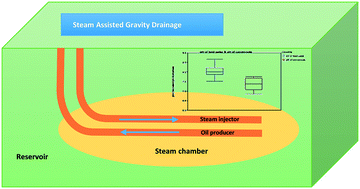Preliminary studies on the impact of in situ oil sand extraction methods on the movement of water soluble organics and inorganics by a pilot scale test†
Abstract
The oil sands of Alberta, Canada constitute the world's largest bitumen reserve. In situ extraction methods are used to recover deeper bitumen resources. Thermal methods are commonly used, for which, steam is generated on the surface and injected underground to heat the reservoir, and thereby improve the flow of the bitumen. The overall objective of this study was to understand what happens to the chemistry of water that is pumped down as steam into an oil sand formation during in situ thermal recovery operations, as well as to the water that is already in the formation as groundwater. In this paper, apparatus has been designed on a pilot scale and used to study mineral–water reactions at the temperatures and pressures observed underground in a steam chamber formed during in situ oil sand operations with a focus on both soluble organics and inorganics. The results showed that there were reactions occurring between the minerals and water as evidenced by the change in anion concentration, pH and pE of the aqueous solutions. This pilot scale study demonstrates that the underground inorganic and organic water chemistry could change during the high-temperature thermal in situ oil sand extraction process.



 Please wait while we load your content...
Please wait while we load your content...